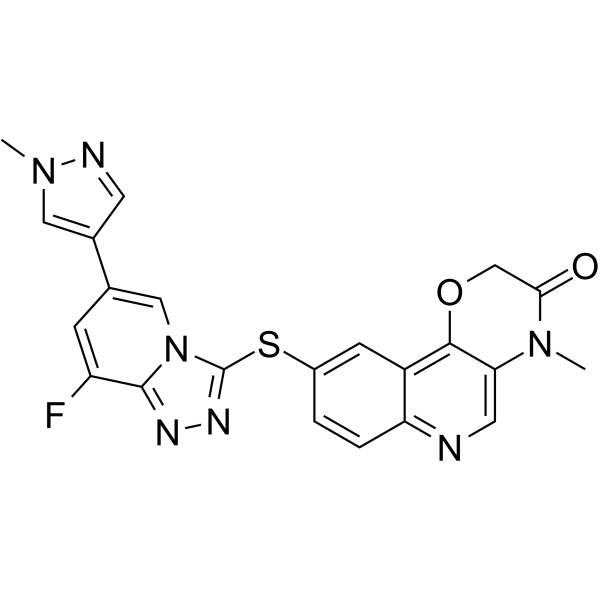| In Vitro |
Dalmelitinib (Compound 4 d) binds to the ATP-binding region of c-Met kinase, and shows slective inhibitory activity against c-Met with an IC50 value of 2.9 nM[1]. Dalmelitinib (0-1 μM approximately, 3 days) inhibits cell proliferation in various c-Met oncogene amplification cancer cell lines, with IC50 values ranging from 6 nM to 33 nM[1]. Dalmelitinib (0.1-1 μM, 6-24 h) significantly induces the phosphorylation of the tyrosine kinases (MET), partially or completely inhibits the downstream phosphorylation of ERK and AKT in HCCLM3 cells[1]. Cell Proliferation Assay[1] Cell Line: C-Met oncogene amplification cancer cell: SNU-5, HCCLM3, MHCC97-H, MHCC97-L, MKN-45, NCI-H1993. No C-Met oncogene amplification cancer cell: Huh-7, NCI-N87, NCI-1975, A549. Concentration: 0-1 μM approximately. Incubation Time: 3 days Result: IC50: 33 nM (HCCLM3), 6 nM (MHCC97-H, MKN-45), 7 nM (MHCC97-L), 14 nM (NCI-H1993), 2 nM (SNU-5); Other cells: > 1000 nM. Western Blot Analysis[1] Cell Line: C-Met oncogene amplification cancer cell: SNU-5, HCCLM3, MHCC97-H, MHCC97-L, MKN-45, NCI-H1993. No C-Met oncogene amplification cancer cell: Huh-7, NCI-N87, NCI-1975, A549. Concentration: 0.1, 0.3, 1 μM Incubation Time: 6-24 h Result: Significantly induced the phosphorylation of the tyrosine kinases (MET), partially inhibited the downstream phosphorylation of AKT, and completely inhibited the downstream phosphorylation of ERK.
|
| In Vivo |
Dalmelitinib (Compound 4 d, intragastric administration, 10-60 mg/kg) significantly inhibits the tumor growth in a dose-dependent manner in MKN-45 tumor xenograft nude mice[1]. Dalmelitinib (intragastric administration, 5 mg/kg for a single dose) shows a high plasma concentration, longer half-life and mean residence time, low clearance rates in BALB/c small nude mice[1]. Dalmelitinib shows a high level of No Observed Adverse Effect Level (NOAEL) in mice long-term toxicity (225 mg/kg/day) and acute toxicity (600 mg/kg/day)[1]. Animal Model: MKN-45 tumor xenograft nude mice[1] Dosage: 10, 30, 60 mg/kg Administration: Intragastric administration Result: Inhibited the tumor growth with the inhibitory rates of 29.5% (10 mg/kg), 34.2% (30 mg/kg), and 61.4% (60 mg/kg). Animal Model: BALB/c small nude mice (pharmacokinetic assay)[1] Dosage: 5 mg/kg for a single dose Administration: Intragastric administration Result: Pharmacokinetic profile of Dalmelitinib (Compound 4 d) Compound Cmax (ng/mL) AUC (ng/mL/h) t1/2 (h) MRT (h) CL/F (mL/min/kg) Vz/F Dalmelitinib 8628 122487 5.55 9.10 0.68 327
|
